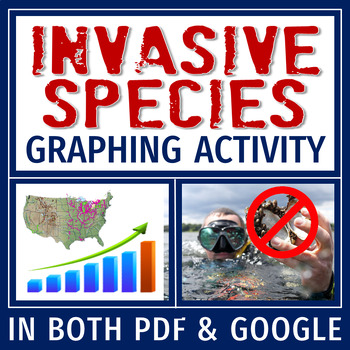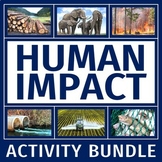Invasive Species Activity Graphing Human Impact on Environment PDF AND DIGITAL
Flying Colors Science
4.8k Followers
Grade Levels
7th - 10th
Subjects
Resource Type
Standards
NGSSMS-LS2-5
NGSSMS-LS2-4
NGSSMS-ESS3-4
Formats Included
- PDF
- Google Apps™
Pages
5 pages
Flying Colors Science
4.8k Followers

Includes Google Apps™
The Teacher-Author indicated this resource includes assets from Google Workspace (e.g. docs, slides, etc.).
What educators are saying
Very high quality activity for my students. I printed out the questions and the students found the resource reading in their Google Classroom. Its great as classwork, or homework.
We had such fun with this resource! It kept students engaged and required very little prep. This teacher has great products!
Also included in
- Engaging lessons on how humans impact ecosystems! Includes activities for habitat destruction, invasive species, and overexploited species. Also includes a webquest about how people can restore ecosystems, and a culminating project about STUDENTS' LOCAL ECOSYSTEMS! Covers standards: MS-LS2-4, MSPrice $14.99Original Price $21.48Save $6.49
- Never search for "something to do tomorrow" ever again! This bundle contains PRINT AND GO lessons, NO PREP activities, LOW PREP labs, and ENGAGING articles to supplement and thoroughly enhance a life science course. Every included resource is easy to implement, standards-based, and high-quality.Price $399.99Original Price $750.85Save $350.86
- SAVE 35% off list prices! Engage students with CRITICAL THINKING as you teach them about how humans have impacted ecosystems around the world. The 12 included resources provide fun, NGSS-based activities for each of the following topics:Habitat Destruction Overharvested ResourcesInvasive SpeciesWatPrice $39.99Original Price $62.90Save $22.91
Description
Read about and GRAPH the growth of an invasive species and its impact on a native species and biodiversity! Includes both PRINT and GOOGLE versions!
⭐Get this activity at a discount in our Human Impact ACTIVITY BUNDLE!
This activity has the following sections:
- READING: Students read a 2-slide informational text about zebra mussels, an invasive species in North America. The article includes how the zebra mussels spread and their negative impact on biodiversity in the new ecosystems.
- GRAPHING INVASIVE SPECIES: Students are given data about the increasing population of zebra mussels by year and graph the information on a provided graph.
- GRAPHING NATIVE SPECIES: Students are given data and information about swan mussels, a native species, and graph the negative impact of zebra mussels on their population.
- ANALYSIS: Students answer concluding analysis questions, including a claims-evidence-reasoning grid.
Teacher Notes:
- You may also be interested in our Top 10 Invasive Species Article!
- INCLUDES ANSWER KEY
- Please note: This PDF resource is NOT editable.
- NGSS Standards: MS-LS2-4, MS-LS2-5, and MS-ESS3-4
- NGSS Science & Engineering Practice: Analyzing and interpreting data
- NGSS Science & Engineering Practice: Using mathematics and computational thinking
- NGSS Science & Engineering Practice: Engaging in argument from evidence
- Save BIG when you combine resources in our Human Impact on the Environment ACTIVITIES BUNDLE!
Total Pages
5 pages
Answer Key
Included
Teaching Duration
N/A
Report this resource to TPT
Reported resources will be reviewed by our team. Report this resource to let us know if this resource violates TPT’s content guidelines.
Standards
to see state-specific standards (only available in the US).
NGSSMS-LS2-5
Evaluate competing design solutions for maintaining biodiversity and ecosystem services. Examples of ecosystem services could include water purification, nutrient recycling, and prevention of soil erosion. Examples of design solution constraints could include scientific, economic, and social considerations.
NGSSMS-LS2-4
Construct an argument supported by empirical evidence that changes to physical or biological components of an ecosystem affect populations. Emphasis is on recognizing patterns in data and making warranted inferences about changes in populations, and on evaluating empirical evidence supporting arguments about changes to ecosystems.
NGSSMS-ESS3-4
Construct an argument supported by evidence for how increases in human population and per-capita consumption of natural resources impact Earth’s systems. Examples of evidence include grade-appropriate databases on human populations and the rates of consumption of food and natural resources (such as freshwater, mineral, and energy). Examples of impacts can include changes to the appearance, composition, and structure of Earth’s systems as well as the rates at which they change. The consequences of increases in human populations and consumption of natural resources are described by science, but science does not make the decisions for the actions society takes.








